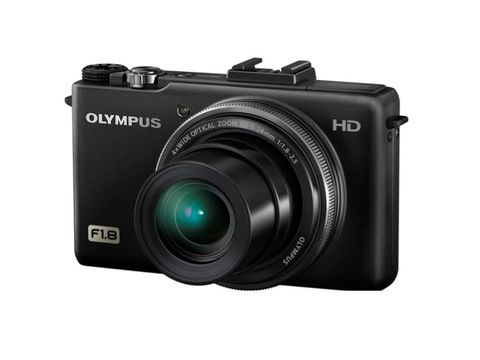Why you can trust TechRadar
Olympus has opted for understated elegance with the XZ-1 body. It feels well made and comfortable to hold. The XZ-1's body isn't littered with control buttons and dials, so even though it's small (think Olympux XZ-1 vs Panasonic LX5 or Olympux XZ-1 vs Canon S95 rather than vs Canon G12 or Nikon P7000) there is still room for your fingers and thumb.
While the front of the camera is smooth and grip-free (the raised letter of the Olympus badge provides the only purchase) the rear has a textured rubber pad in the natural thumb resting position and this helps to make the camera feel safe in your grasp. It prevents the XZ-1 from slipping between your fingers when composing a shot one-handed.
Of course keeping the number of buttons down means that there are a few direct controls missing. There's no sensitivity or white balance button or dial for example. Fortunately these options and 11 others can be reached reasonably quickly via the XZ-1's control screen, which is accessed by pressing the OK button the camera back.
Although it's not unusual for a compact camera (or an SLR for that matter), the Olympus XZ-1 has an exposure compensation button which is used in conjunction with the adjustment dial. I much prefer the immediacy of the exposure compensation dials found on the Canon G12 and Nikon P7000, but these are substantially larger cameras.
When you look at the Olympus XZ-1 vs the Canon S95, the XZ-1 also has a dial around the lens barrel that is used to select the aperture setting in aperture priority and manual exposure mode, and shutter speed in shutter priority mode. It's quick, easy to use and given the unusually large number of aperture settings that the Olympus XZ-1 has for a compact camera, it's much better than continual button pressing.
It's not a major issue, but I found that the mode dial changed position fairly easily, and on a few occasions the camera switched modes while I was carrying it between shots. A mode dial lock would prevent this, but it would also slow down deliberate changes. The message for the XZ-1 is to check the mode dial before taking a shot.
In summary, the Olympus XZ-1 is very pleasant camera to use. Olympus has kept the menus short and to the point, but there are few occasions when it is actually necessary to use them. There are automatic shooting options available for the less experienced photographer (iAuto and scene modes etc) as well as more advanced options for enthusiast photographers. Unless the ambient light is very bright, the 3-inch, 610,000-dot LCD screen also provides a decent view of the image being composed, but it's a little over-saturated.
Current page: Olympus XZ-1: Build and handling
Prev Page Olympus XZ-1: Overview Next Page Olympus XZ-1: Performance
